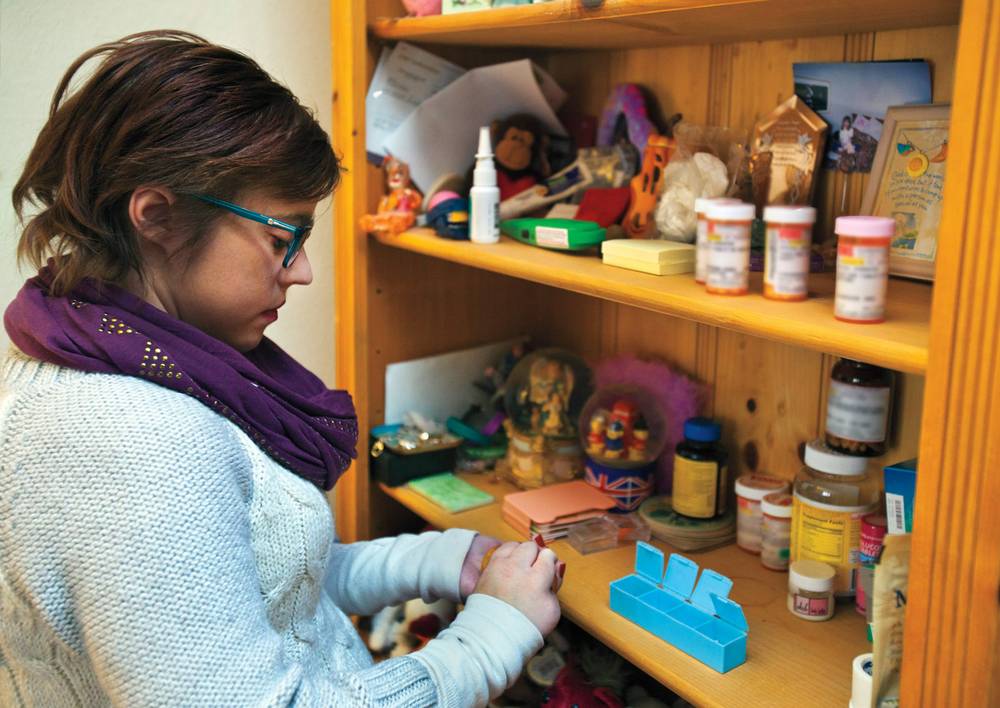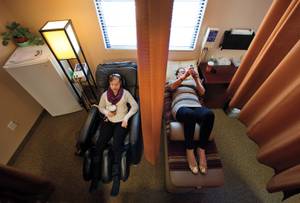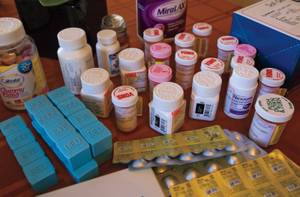Death and illness are scary things, but the one thing a sick person needs is to not be left alone. More than anything, friends and family are the things that anchor our belief in our fight. —December 2, 2013
It’s a chilly September morning at Tivoli Village, and Jenny Stiles sits cozily behind oversized black sunglasses that match her lacquered nails. A red pixie cut frames her pale cheeks, and an ear-to-ear smile pops from a swipe of coral lipstick. She fits in perfectly on the Italian café’s bustling patio and greets me with a warm hug. That same smile flashes again as she pauses from conversation to sip her half-full lemonade (she would never call it half-empty), nothing about her letting on that one day earlier she was hooked up to a machine that filters her blood, doing the job her failing kidney cannot.
Among other undiagnosed birth defects, Jenny was born with polycystic kidney disease and chronic pancreatitis. At 26 years old, she’s in Stage 5 kidney failure, preparing for her second kidney transplant—she underwent the first at age 12—and her first pancreas transplant. Through her smart phone, she uploads her life onto Facebook and Twitter, but instead of sharing selfies and fancy food snapshots, she posts pictures of needles and medical equipment, documenting doctor visits and dialysis.
Throughout Jenny’s life, she estimates the cumulative cost of her treatment has soared into the millions. Her immunosuppressant drugs alone cost $3,000 to $5,000 each month, before insurance, and she’s required to take them for the rest of her life. Her transplant hospital, Cedars-Sinai Medical Center in Beverly Hills, requires that Jenny stay nearby for rehabilitation after her kidney transplant and again after her pancreas transplant, which can’t be done at the same time. But crashing in the California hills isn’t something Jenny’s family can afford out of pocket. Cedars’ financial coordinator Martha Alonso suggested that Jenny look to crowdfunding to help pay for housing, transportation and food—the costs you don’t think about when you’re focused on survival.
“I’m not very good at asking for money for myself,” Jenny says, but on August 15, she sent a note to her Facebook friends, asking them to donate to her online fundraiser: “My family … will be losing my mom’s income for a month or more to take care of me,” Jenny wrote. “My parents would spend every dime they had to make sure I have this lifesaving surgery; I am just hoping they don’t have to.”
Up and kinda ready for surgery. I don’t know why, but I am very nervous. —September 13, 2013
Jenny’s mother, Karen, didn’t know her daughter would be born with medical issues. Jenny’s older brother was totally healthy, so there was no reason to think Jenny would be any different. But when she was born on July 7, 1987, Karen quickly learned her baby was sick. Jenny was born with diseased organs and birth defects ranging from one leg that’s longer than the other to bowels rotated the wrong way.
“She started having surgeries when she was 6 months old,” Karen says. “Every day something new was wrong. She had kidney disease; she had no soft spot on her skull. She was going to die.” Karen’s plan to be a stay-at-home mom while her husband Dennis ran his own business was no longer an option.
“We paid our premiums monthly through Blue Cross Blue Shield,” Karen says, “but when [Jenny] was born … they started raising our premiums so high that we couldn’t afford to pay them. We couldn’t afford the insurance anymore.” Karen went back to work full-time at a local grocery store so Jenny would have coverage. To date, she has had more than 20 surgeries to, among other things, remove both her kidneys and two-thirds of her pancreas, create ducts in her organs and form a pathway known as a fistula that’s used as an entry point during dialysis. “You have to realize,” Jenny says, “I was born this way. I was born [with] pre-existing conditions.”
Karen’s insurance took on most of Jenny’s health costs, but it hasn’t been without sacrifice. “My mom has worked this job … for basically 24 years, for me,” Jenny says. “My mom works for my insurance. My mom has no choice. She can’t change jobs; she can’t do anything different. We may not have gone broke, but there’s no way we could ever pay for everything [without it]. My mom has carried the burden.”
When Jenny got accepted into Cedars-Sinai’s kidney transplant program, she had to agree to stay near the facility for at least a month to accommodate surgery prep and aftercare, during which her mom will be her primary caregiver—and that means losing Karen’s income for at least a month. Alonso, Cedars’ financial coordinator, says it’s common practice to give patients a list of resources, from fundraising platforms to assistance programs for travel expenses, though very few end up turning to crowdfunding. Out of the seven recommended fundraising platforms, Jenny and Karen chose the nonprofit HelpHopeLive. As Jenny waits for potential kidney donors to get tested, she’s been raising money through an online campaign. Her goal is $20,000.
Crowdfunding for creative projects like film, art and music paved the way for this new means of paying for health care. For those who are uninsured or whose insurance doesn’t cover enough, turning to the Web seems like the last frontier in an ongoing health care saga. But it isn’t a free-for-all. Jenny can’t use well-known platforms like Kickstarter or Indiegogo; she’d lose her Medicaid if she made more than $2,000. “Medicaid is based off of income,” Alonso says. “Right now, [Jenny’s] using her private insurance, and she’s able to send the balances to Medicaid.” Through HelpHopeLive, an account is opened under a fundraiser tax ID number, and the foundation pays for services.
Active since August, Jenny’s campaign has raised just over $1,000. “I’m just trying to cover hotel costs. That would be very helpful to my family,” she says. “Obviously, if I can make the whole $20,000, we won’t have to worry about a thing.”
Her goal isn’t unreasonable, says Alonso, who estimates the average cost of aftercare is $20,000 to $30,000. “We try to have them aim high,” Alonso says. Between hotel rooms, car rental, co-pays, meals and airfare, the money can add up quickly.
While her mom does more grass roots work, like fundraising at BJ’s Restaurant and California Pizza Kitchen, or throwing a punk rock yoga benefit, Jenny maintains the online effort. It makes sense. She’s constantly connected to social media, whether through her cell phone during dialysis or on her Acer laptop at home.
Her first experience with social media came during dialysis at 11 years old, when she’d webcam chat with other kids on dialysis at different clinics around the country. At 18, she started playing Second Life, an online virtual reality game that allows users to create 3D renderings of themselves that engage in real or fantasy-based scenarios and relationships. That’s how Jenny met her long-distance boyfriend, Darren Pearce, who lives in England and has an undiagnosed autoimmune disease. In the game, Jenny and Darren can do things that geography and their sensitive health conditions don’t allow, like go on a date or even live together. “We started living together after two months,” Jenny says, laughing.
A typical date for the couple starts out at home, in the house that Darren built. They usually end up at a club, where they dance and listen to jazz. That was their first date. “It wasn’t actually a ‘date’ date, we were just incredibly bored,” Jenny says. “None of our friends were on[line], [so] he took me dancing to a ballroom place called Cloud 9. That’s always been my favorite date.” The two haven’t been active on SL lately, though. When Jenny’s health started declining again she stopped playing. They keep in touch through Facebook, although Darren’s disability has made it difficult for him to use a computer.
“It really helps to have your partner be someone who understands,” Jenny says. “He just keeps me going.” When she hasn’t posted in a while, Darren starts to worry, because even when she feels her worst she’s usually connected to Facebook or Twitter. “That’s how I see a lot of my friends who aren’t in Vegas, and a lot of people who I care about. They know what’s going on with me through social media.”
On my way to the hospital to get checked for another blood clot. —September 25, 2013
In March 1999, when Jenny was 12, Karen donated a kidney to her daughter in a successful transplant. Through it all Karen has maintained a wildly positive attitude that’s gotten both mother and daughter through the roughest parts of Jenny’s disease. “I couldn’t raise her to be ‘poor Jennifer,’” Karen says. “You have to help other people; you have to have empathy.”
The transplant was successful, but the immunosuppressant drugs Jenny needed landed her back in the hospital. By the time she was 13, she had developed a severe infection in her pancreas and spleen, forcing doctors to perform emergency surgery. “They couldn’t figure out what was wrong with me,” Jenny says. “Finally, they realized I had a huge, giant infection spreading. They said it looked like melted cheese on my organs.”
As a result, Jenny lost most of her pancreas, causing her to develop diabetes. With the help of a strict “kidney” diet, 26 medications and an insulin pump, she’s maintained a relatively active lifestyle for more than 13 years.
As a teenager, Jenny loved high school and participated in theater, speech and debate, excelling in academics and making friends easily. In spite of her disability, she graduated in four years with an advanced diploma—meaning she took six more classes than required—from Palo Verde High in 2005. “I was probably one of the only people I know that adored high school. ... I was a nerd,” she laughs.
After a few years of living with pregnancy-like symptoms—missed periods, hot flashes, cold sweats, nausea and hair growth—Jenny was finally diagnosed with polycystic ovarian syndrome around age 17. At one point, she had a grapefruit-sized cyst on her ovary that popped before surgery. Today, she’s on a strict hormone regimen that keeps her symptoms—which feel like “menopause and pregnancy at the same time”—at bay.
Before her donor kidney began failing, Jenny was studying at UNLV, working on her bachelor’s in journalism with a focus on social media and a minor in women’s studies and creative writing. At school, she’s a go-getter—an alum of the National Education for Women’s Leadership program and a past co-chair of UNLV’s annual Take Back the Night event where the community speaks out against domestic violence and sexual assault. But when Jenny’s kidney began functioning at just 30 percent more than a year ago, she was forced to take medical leave first from work and then school. She’s currently in end-stage kidney failure, waiting for a donor and receiving dialysis three hours a day, three days a week. Between medical visits, she catches up on a huge reading list (right now she’s into the Divergent trilogy) and watches stand-up comedy (her favorites are Russell Brand and Craig Ferguson) and Doctor Who episodes. But Jenny says she misses being a productive, active student. With no work and no school, she says, “life is boring like this.”
Waiting for potential donors to get tested could take up to six months. In the meantime, Karen is training to become a dialysis technician so Jenny can receive treatment at home. When she isn’t working, Karen drives Jenny to doctors appointments, stays with her during dialysis and makes sure everything goes smoothly. “I just consider myself a mom. This is what moms are supposed to do.”
Jenny’s personality is just as buoyant. She hates “pity face,” the reaction she says she often gets when people hear she’s sick. But when she agrees to a Skype interview during a dialysis treatment in November, she appears more tired than she had in our first two interviews. Her pink lipstick is gone. Dressed in a bright pink hoodie and wearing the same sunglasses from that day at Tivoli Village, she guides me through her weekly routine of tubes and fluids.
“So this one right here is [where] my blood comes back,” she says, pointing to one of the many coils of plastic attached to her body, her nails still perfectly painted. “The blood comes out of here, it goes through the machine right there, and it filters out any impurities that I have that normally kidneys would do.”
Back in September, Jenny was having complications with her blood pressure, spiked by one of her medications. By November it’s back under control, though she’s still struggling with tachycardia (an accelerated heart rate) and heart palpitations during dialysis. She fills me in on new details regarding her kidney and her fundraiser. I ask about her thoughts on organ donation—what would she say to someone interested in donating a kidney, but scared to go through the surgery?
There’s a long pause, and her face starts to scrunch up behind the black lenses of her glasses. “I understand it’s scary,” she responds slowly. “I’ve been through 24 surgeries. I still get nervous and scared. Right now, there are tons of people around here that are dying. None of us can leave this city,” she says, referring to the other patients in the dialysis clinic. “Honestly, I am stuck. No work. No school. I can’t go see Darren. I can’t go see my family. I have a brand new nephew I can’t see.” The sound of Karen’s voice, concerned, indicates a problem. Jenny’s blood pressure is rising fast.
Her mom gives her a pill to bring it back down, and Jenny takes a minute to catch her breath, leaning her head back on the headrest. “I got overly passionate,” she says. “You should see me in a debate. … It’s scary to go through surgery; it’s scarier to know you’re dying without being around your family. Without being able to be the person you were before the disease. I’m not the same person right now.”
When she gets better, Jenny wants to get back where she was, working, going to school and helping plan events like Take Back the Night. “I didn’t raise her to be a sick child; I raised her to be a decent human being,” Karen says. “If you let [the disease] define you as a person, you might as well hang it up and call it quits. This is a bump in the road. And we’ll get through this, too.”
I have decided, my health willing, I am going to make a pie for Thanksgiving this year. —October 18, 2013
Thanks in part to the Internet and online activists, live organ donation is gaining more attention and myths and fears about transplantation are being dispelled. Ask live organ donation activist and comedian Amy Donohue if she ever got scared before donating her kidney, and she’ll tell you it didn’t matter—nothing could have stopped her.
A self-described “social media junkie,” Donohue decided to donate her kidney when she saw a tweet from a friend she’d met through social media. “I learned that [Kirti Dwivedi’s] mother was sick with kidney disease in January, almost three years ago. I saw her tweet that her mom had finally agreed to be put on the donor list to get a kidney [after being sick for 10 years]. Cadaver kidneys can take two to six years to get, and it wasn’t likely she would live that long,” Donohue says.
Donohue’s only complaint about her kidney donation is that she had no one to talk to leading up to the procedure. Then, three weeks before her operation, she saw a story on Facebook about a Detroit comedian who donated his kidney because of social media. “I searched Ricky Cisco out on Facebook and I messaged him,” Donohue recalls. “I said, ‘Ricky, I’m about to donate my kidney. I’ve had nobody to talk to. How do you feel?’” Ricky told her that, just days out of his operation, he felt great, and the weight was lifted.
In March of this year, Donohue started #Kidneychat, a live weekly Twitter group where people can get answers to all donation-related questions: the scary ones, like mine, and the not-so-scary ones, like, “Can you still drink booze with just one kidney?” In less than a year, #Kidneychat has grown into a community not just for donors, but for people who are on dialysis, their family members and even doctors, Donohue says.
“We talk about everything. We talk about body functions,” she says. “They don’t feel uncomfortable; they don’t feel like a burden because they’re sick. They’re real people surrounded by real people who are showing support.”
Some #Kidneychatters tweet during dialysis, like Jenny, who talks with members of the group from her smart phone. “You’re sitting in a chair for hours a day, for three or four days a week. It becomes a job,” says Donohue, who’s proud of her creation and is working on a documentary called Social Media Stole My Kidney.
Jenny has a pool of potential donors being tested, but finding a kidney isn’t the only factor in saving a transplant recipient’s life. Having hit the first $1,000 of her fundraiser, Jenny is happy with its progress but remains $19,000 away from peace of mind. If she doesn’t make her goal, it will mean more hardship for her parents. “I have to reach a bigger group than just local,” she says, hoping she’ll eventually get the kind of support usually reserved for film directors or rock musicians.
But Jenny is a rock star to the people who know her—her family, her friends, even her dialysis tech. “[He’s] like, ‘You haven’t lost hope,’ and I’m like, ‘I can’t,’” she says. “Once you get that transplant, as long as it’s a good working transplant, honestly, your life is normal.”
Going to be trying my fistula today. They are using a pretty big needle, here’s hoping it works. —November 7, 2013
Even through the hardest parts of her disease, Jenny says she’s lucky. She’s never been put on a wait list, where people can spend years hoping for a transplant that might not come in time, and she’s able to laugh at the things she can’t control. While preparing for her next transplant, she’s also found a borderless, digital, 24-hour support system where she will continue to raise awareness about life-saving organ donations even after her own surgeries are done.
“If only more people knew the impact their donations have on human life,” she says. “I went from being the sickest child in the world when I was 11 years old—my parents were essentially planning my funeral—to literally bouncing in my hospital bed the next morning.”
Jenny looks forward to waking up that way at Cedars-Sinai. She’s got a ton of things on her to-do list, from traveling to participating in a women’s conference in Washington, D.C., to seeing her family and … eating potatoes. A healthy kidney filters out potassium, so something as simple as a baked potato could trigger a fatal potassium overdose for someone like Jenny. “God, there are those times when you just want to carb-load on a potato. A chili-cheese French fry would be awesome,” she says.
When she gets her journalism degree and “actually gets to that finish line,” Jenny hopes to move in with Darren, this time in real life, thousands of miles away in England. Of course, being an advocate for live organ donation and people with disabilities will always be a big part of her life. But as long as she has a WiFi connection, she can do that anywhere.
Note: This story has been corrected to reflect that Jenny was born with polycystic kidney disease and chronic pancreatitis, but is not currently living with either. She was also born with no soft spot on her skull.








